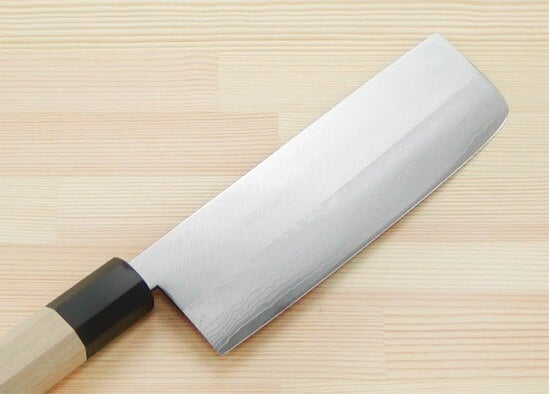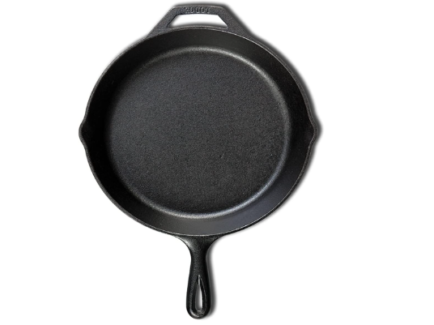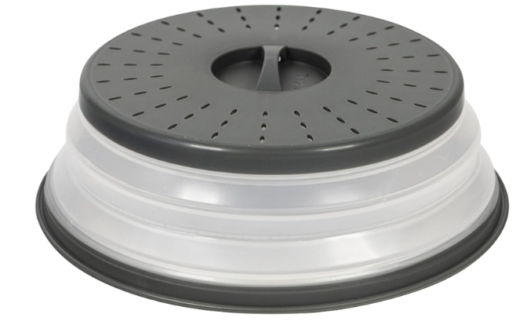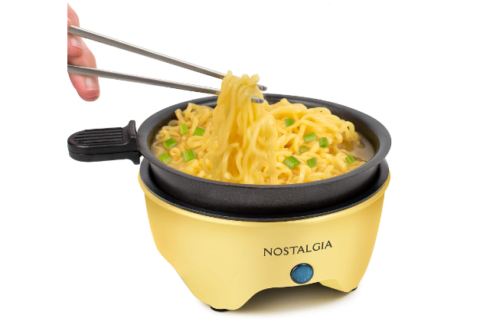A Japanese cleaver, also known as a “nakiri,” is a...
Read More
A Japanese vegetable knife is called a Nakiri, which is a traditional Japanese knife that is used for chopping, slicing, and dicing vegetables. The Nakiri has a thin, rectangular blade with a straight edge that allows for precise cutting, and is typically made from high-carbon steel or stainless steel.
The handle of a Nakiri can be made from a variety of materials, including wood, plastic, or composite materials, and is designed for a comfortable and secure grip.
Nakiri knives are highly valued for their precision and sharpness, making them a popular choice among professional chefs and home cooks alike who want to achieve perfect vegetable cuts for various recipes.
What is a Japanese vegetable knife used for?
A Japanese vegetable knife, also known as a Nakiri, is a specialized knife that is primarily used for chopping, slicing, and dicing vegetables. Its thin, rectangular blade with a straight edge allows for precise cuts, making it an ideal tool for preparing vegetables for various dishes.
The Nakiri knife is designed specifically for the task of cutting vegetables and is different from other Japanese knives, such as the Gyuto (Japanese chef’s knife), which has a more versatile shape and can be used for meat and fish as well.
The thin, straight blade of a Nakiri knife makes it easy to slice through vegetables, such as onions, carrots, celery, and cucumbers, with minimal effort. The straight edge also allows for clean and precise cuts, making it ideal for preparing vegetables for salads, stir-fries, and other dishes.
Overall, a Japanese vegetable knife or Nakiri is an essential tool for any chef or home cook who wants to achieve perfect cuts and textures for vegetables in their recipes.
What size is a Japanese vegetable knife?
The size of a Japanese vegetable knife, or Nakiri, can vary depending on the manufacturer and the intended use of the tool. However, in general, a Nakiri knife has a blade length ranging from 5 inches to 7 inches, with an overall length of 10 inches to 14 inches.
The blade of a Nakiri knife is typically thin and rectangular in shape, with a straight cutting edge that extends from the tip of the blade to the heel. The blade’s width can vary depending on the specific Nakiri knife, with some models having wider blades for increased chopping power and others having narrower blades for more delicate slicing.
The handle of a Nakiri knife can also vary in size and shape, with some handles being simple and straight, while others are more contoured and ergonomic, designed to fit comfortably in the hand for extended periods of use.
Overall, the size of a Nakiri knife is relatively small compared to other types of knives, making it a highly maneuverable tool for precise cutting and chopping of various vegetables.
Benefits of using Japanese vegetable knife
There are several benefits to using a Japanese vegetable knife or Nakiri, including:
- Precision: The thin, straight blade of a Nakiri allows for precise cuts, making it ideal for vegetable preparation tasks that require accuracy and attention to detail.
- Versatility: A Nakiri can be used to chop, slice, and dice a variety of vegetables, making it a versatile tool for preparing various dishes.
- Efficiency: The sharp blade of a Nakiri allows for efficient and quick vegetable preparation, saving time and effort in the kitchen.
- Comfort: The ergonomic handle of a Nakiri provides a comfortable grip and reduces strain on the hand and wrist, allowing for extended use without fatigue.
- Health benefits: Using a Nakiri to chop vegetables can reduce the risk of injury compared to using a larger knife or a dull knife. Additionally, the precise cuts produced by a Nakiri can help preserve the nutritional value of the vegetables.
- Tradition: The Nakiri knife is a traditional Japanese tool that has been used for centuries in Japanese cuisine, and using one can help connect you to this rich history and cultural heritage.
Overall, a Japanese vegetable knife or Nakiri is a highly versatile and efficient tool that provides precision, control, and comfort, making it an excellent choice for anyone who wants to achieve perfect cuts and textures for vegetables in their recipes.
What is the difference between a chef knife and a vegetable knife?
The main difference between a chef knife and a vegetable knife is the blade shape and size, which affects their primary uses and capabilities in the kitchen.
A chef knife, also known as a Gyuto in Japanese cuisine, has a larger, wider blade with a tapered shape that gradually narrows from the heel to the tip. This blade shape allows for versatile cutting and chopping of various ingredients, including meat, fish, and vegetables. The blade length of a chef knife can range from 6 to 12 inches, with an average length of around 8 inches.
A vegetable knife, on the other hand, typically has a shorter and narrower blade, ranging from 5 to 7 inches in length. The blade is typically thinner and lighter than a chef knife, and its straight, flat edge allows for precise and controlled cutting of vegetables, including slicing, dicing, and chopping.
While a chef knife is designed for versatility and can be used for various kitchen tasks, a vegetable knife is specialized for vegetable preparation, and is not as suitable for other tasks such as meat and fish preparation.
In summary, the key differences between a chef knife and a vegetable knife are the size, shape, and capabilities of their blades, with chef knives being more versatile and suitable for a broader range of kitchen tasks, while vegetable knives excel at precise vegetable preparation.
How to use Japanese vegetable knife safely
Using a Japanese vegetable knife or Nakiri safely is essential to prevent injuries and ensure efficient and effective vegetable preparation. Here are some tips for using a Japanese vegetable knife safely:
- Grip the handle firmly: Make sure to grip the handle of the knife firmly with your hand, keeping your fingers and thumb behind the bolster or guard. This will ensure stability and control while cutting.
- Use a cutting board: Always use a cutting board to protect your countertop and prevent the knife from slipping. Choose a stable and non-slip cutting board made of wood, bamboo, or plastic.
- Hold the vegetable securely: Use your non-dominant hand to hold the vegetable securely in place on the cutting board. Keep your fingers curled under and away from the blade to avoid injury.
- Use a proper cutting motion: Use a rocking motion with the knife, starting at the tip and ending at the heel, to make clean, precise cuts. Avoid using a sawing motion, which can damage the blade and make uneven cuts.
- Keep your eyes on the blade: Always keep your eyes on the blade while cutting to prevent accidents and ensure precise cutting.
- Use proper storage: Store the knife in a proper storage place, such as a knife block or sheath, to prevent injury and protect the blade.
- Keep the knife sharp: Use a sharpening stone or honing steel to keep the blade sharp, as a dull blade is more likely to slip and cause injury.
By following these tips, you can safely and efficiently use a Japanese vegetable knife or Nakiri in the kitchen, ensuring precise and consistent vegetable preparation while avoiding injury.
Factors to consider when choosing the best Japanese vegetable knife
Here are some factors to consider when choosing the best Japanese vegetable knife:
- Blade Material: The blade of a Japanese vegetable knife is typically made of high-carbon stainless steel, which is durable and resistant to corrosion. Consider the quality of the steel and whether it is easy to maintain and sharpen.
- Blade Shape and Size: Japanese vegetable knives come in a range of shapes and sizes, including nakiri, usuba, and santoku. Choose a blade shape and size that fits your needs and comfort level.
- Handle Material: Japanese vegetable knives often have wooden handles, which can provide a comfortable and secure grip. Consider the type of wood and whether it is resistant to moisture and splintering.
- Blade Thickness: The thickness of the blade can affect the knife’s balance and ease of use. A thinner blade may be more maneuverable, while a thicker blade may be more durable.
- Weight and Balance: Consider the weight and balance of the knife, as these factors can affect how comfortable it is to use. A well-balanced knife can reduce strain on your wrist and forearm, making it easier to use for extended periods.
- Brand Reputation: Consider the reputation of the brand and whether they have a history of producing high-quality, reliable knives. Look for brands that use traditional craftsmanship techniques and materials.
- Price: Japanese vegetable knives can range in price from around $50 to over $500. Consider your budget and how often you will be using the knife when deciding how much to spend.
By considering these factors, you can choose the best Japanese vegetable knife for your needs and preferences, ensuring that you have a high-quality, reliable knife that can help you prepare delicious meals for years to come.
How to clean Japanese vegetable knife
Cleaning your Japanese vegetable knife after each use is important to keep the blade clean and prevent corrosion. Here are the steps to clean a Japanese vegetable knife:
- Rinse the blade: After use, rinse the blade of the Japanese vegetable knife under warm water to remove any food particles or debris.
- Wash the blade with mild soap: Apply a small amount of mild dish soap to the blade and use a soft sponge or cloth to gently wash the blade. Be sure to clean both sides of the blade, paying particular attention to any areas where food may have become trapped.
- Rinse the blade again: Rinse the blade thoroughly under warm water to remove all soap residue.
- Dry the blade: Dry the blade completely with a soft towel or cloth. Make sure to dry the blade thoroughly to prevent water spots or rust from forming.
- Oil the blade: If desired, apply a thin layer of food-grade mineral oil to the blade to protect it from moisture and prevent rust. Make sure to wipe off any excess oil before using the knife.
- Store the knife properly: Store your Japanese vegetable knife in a knife block, sheath, or on a magnetic strip to protect the blade and keep it safe from children or pets.
Remember, never put your Japanese vegetable knife in the dishwasher, as this can cause the blade to become damaged or dull. By following these steps, you can keep your Japanese vegetable knife clean, sharp, and in excellent condition for many years of use.
How to sharpen Japanese vegetable knife
Here are the steps to sharpen a Japanese vegetable knife:
- Choose the right sharpening stone: Select a sharpening stone that is appropriate for the level of dullness of your Japanese vegetable knife. For example, a coarse-grit stone is good for sharpening very dull blades, while a fine-grit stone is ideal for honing and polishing the blade.
- Soak the sharpening stone: If using a waterstone, soak it in water for at least 10-15 minutes before use. This helps to prevent the blade from becoming damaged during the sharpening process.
- Hold the knife at the correct angle: Hold the blade of the Japanese vegetable knife at an angle of approximately 15-20 degrees to the sharpening stone. You can use a sharpening guide or visual cues to ensure that you maintain the correct angle throughout the sharpening process.
- Begin sharpening the blade: Use a circular or back-and-forth motion to move the blade across the sharpening stone, applying light pressure to the blade. Start with the coarse-grit side of the sharpening stone and work your way up to the finer-grit side.
- Flip the knife over: After sharpening one side of the blade, flip the knife over and repeat the process on the other side of the blade.
- Test the blade: Once you have finished sharpening the blade, test it by slicing through a piece of paper or a soft vegetable. If the blade cuts smoothly and cleanly, it is sharp and ready to use.
- Clean and store the knife: After sharpening your Japanese vegetable knife, clean it thoroughly and dry it carefully. Store the knife in a safe place, such as a knife block or sheath, to protect the blade.
By following these steps, you can sharpen your Japanese vegetable knife and ensure that it remains sharp and effective for all your cooking needs.
How to maintain Japanese vegetable knife properly
To maintain your Japanese vegetable knife properly, follow these tips:
- Clean the blade after each use: Wipe the blade with a damp cloth or sponge and mild soap to remove any food residue or dirt. Rinse the blade with clean water and dry it with a soft towel.
- Store the knife properly: Store your Japanese vegetable knife in a knife block, sheath or on a magnetic strip to protect the blade from damage and keep it safe from children or pets.
- Sharpen the blade regularly: Use a sharpening stone or honing steel to keep the blade sharp. Make sure to follow the manufacturer’s instructions and use the correct technique to avoid damaging the blade.
- Oil the blade to prevent rust: Apply a thin layer of food-grade mineral oil to the blade to protect it from moisture and prevent rust. Make sure to wipe off any excess oil before using the knife.
- Avoid cutting hard foods: Avoid using your Japanese vegetable knife to cut hard foods such as bones, frozen foods or hard cheese. These can damage the blade and cause it to become dull.
- Don’t use the knife as a screwdriver: Avoid using your Japanese vegetable knife to pry open cans, jars or other containers. This can damage the blade and the handle.
- Don’t put the knife in the dishwasher: Japanese vegetable knives should be washed by hand only. Dishwashers can damage the blade and handle, and the high heat can cause the blade to become dull.
By following these tips, you can maintain your Japanese vegetable knife properly and enjoy using it for years to come.
Troubleshooting about Japanese vegetable knife
Here are some common troubleshooting tips for Japanese vegetable knives:
- My Japanese vegetable knife is not cutting well. What should I do? If your Japanese vegetable knife is not cutting well, it may be dull and in need of sharpening. Use a sharpening stone or honing steel to sharpen the blade, following the manufacturer’s instructions carefully. If the blade is damaged or worn, you may need to have it professionally sharpened or replaced.
- My Japanese vegetable knife is rusting. How can I prevent this? To prevent rusting on your Japanese vegetable knife, make sure to dry it thoroughly after washing and storing it in a dry place. You can also apply a thin layer of food-grade mineral oil to the blade to protect it from moisture.
- My Japanese vegetable knife handle is loose. What can I do? If the handle of your Japanese vegetable knife is loose, it may need to be tightened or replaced. You can try tightening the screws or rivets on the handle, but if this doesn’t work, you may need to have the handle repaired or replaced by a professional.
- My Japanese vegetable knife blade is chipped. Can it be fixed? If the blade of your Japanese vegetable knife is chipped, it may be possible to fix it by grinding the edge down with a sharpening stone. However, if the chip is too large or the blade is damaged beyond repair, you may need to have the knife professionally sharpened or replaced.
- My Japanese vegetable knife is stained or discolored. How can I clean it? To clean stains or discoloration on your Japanese vegetable knife, you can use a non-abrasive cleaner or baking soda paste to gently scrub the affected area. Make sure to rinse the blade thoroughly and dry it well afterwards to prevent further staining or discoloration.
Japanese vegetable knife - FAQs
Here are some frequently asked questions (FAQs) about Japanese vegetable knives:
A Japanese vegetable knife, or Nakiri, is used for precise slicing, dicing, and chopping of vegetables in the kitchen. Its straight, flat blade and sharp edge make it ideal for efficient and controlled vegetable preparation.
A Japanese vegetable knife has a straight, flat blade and a sharp edge, while a Western-style chef knife has a curved blade and a more pointed tip. The Nakiri is designed specifically for vegetable preparation, while a chef knife is more versatile and can be used for a wider range of kitchen tasks.
High-quality steel, such as VG-10 or AUS-10, is often used for Japanese vegetable knives due to its durability, sharpness, and resistance to corrosion.
To care for your Japanese vegetable knife, you should wash it by hand with mild soap and water, dry it thoroughly after each use, and store it in a knife block or sheath. Use a sharpening stone or honing steel to keep the blade sharp, and avoid using it on hard surfaces or bones, as this can damage the blade.
With proper care and maintenance, a high-quality Japanese vegetable knife can last for many years, providing reliable performance and precision in the kitchen.
Yes, you can sharpen your Japanese vegetable knife at home using a sharpening stone or honing steel. However, it’s important to use the correct technique and follow the manufacturer’s instructions to avoid damaging the blade. If you’re unsure about sharpening your knife, it’s best to seek the advice of a professional.
Conclusion
In conclusion, the Japanese vegetable knife, or Nakiri, is a versatile and efficient tool for vegetable preparation in the kitchen. With its straight, flat blade and sharp edge, the Nakiri is ideal for precise slicing, dicing, and chopping of vegetables, making it a popular choice among chefs and home cooks alike.
When choosing a Japanese vegetable knife, it’s important to consider factors such as the blade material, thickness, shape, handle design, blade length, brand reputation, and price. By selecting a high-quality Japanese vegetable knife that suits your preferences and needs, you can ensure efficient and safe vegetable preparation, while enjoying the benefits of using a well-crafted and durable kitchen tool.
With proper care and maintenance, a Japanese vegetable knife can last for many years, providing reliable performance and precision in the kitchen. Whether you’re a professional chef or a home cook, a Japanese vegetable knife is a valuable addition to any kitchen toolkit, allowing you to prepare vegetables with ease and precision, and elevate your cooking to the next level.
Related Posts
Best Japanese Kitchen Knife Set
In the city of Sakai, the ancient art of making...
Read MoreThe Best Japanese Knives You Should Have In The Kitchen
Knives are the foundation of any chef’s arsenal. If you’re...
Read MoreWhy Trust Us
You will find what you are looking for at Jody's Bakery. From classic to luxury brands, you'll find both. We will help you to select appliances that fit your needs, budget and lifestyle. Whether you want to stop by to learn more — or plan to make a major purchase — we’ll treat you like family and assist you every step of the way. Shop with us today to receive friendly and experienced help along the way.
















I thoroughly enjoyed this piece. It was both informative and engaging, providing a lot of valuable information. Let’s discuss further. Check out my profile for more interesting content.
… [Trackback]
[…] Read More here to that Topic: jodysbakery.com/what-is-a-japanese-vegetable-knife-used-for/ […]
… [Trackback]
[…] Find More to that Topic: jodysbakery.com/what-is-a-japanese-vegetable-knife-used-for/ […]
… [Trackback]
[…] Find More on that Topic: jodysbakery.com/what-is-a-japanese-vegetable-knife-used-for/ […]
… [Trackback]
[…] Read More Info here to that Topic: jodysbakery.com/what-is-a-japanese-vegetable-knife-used-for/ […]
… [Trackback]
[…] Read More here on that Topic: jodysbakery.com/what-is-a-japanese-vegetable-knife-used-for/ […]
… [Trackback]
[…] Here you can find 16516 additional Info on that Topic: jodysbakery.com/what-is-a-japanese-vegetable-knife-used-for/ […]
… [Trackback]
[…] Find More on to that Topic: jodysbakery.com/what-is-a-japanese-vegetable-knife-used-for/ […]
… [Trackback]
[…] Read More Information here on that Topic: jodysbakery.com/what-is-a-japanese-vegetable-knife-used-for/ […]
… [Trackback]
[…] There you can find 89029 more Info on that Topic: jodysbakery.com/what-is-a-japanese-vegetable-knife-used-for/ […]
… [Trackback]
[…] Read More Information here to that Topic: jodysbakery.com/what-is-a-japanese-vegetable-knife-used-for/ […]
… [Trackback]
[…] Read More here to that Topic: jodysbakery.com/what-is-a-japanese-vegetable-knife-used-for/ […]
… [Trackback]
[…] Find More Info here on that Topic: jodysbakery.com/what-is-a-japanese-vegetable-knife-used-for/ […]
… [Trackback]
[…] Info to that Topic: jodysbakery.com/what-is-a-japanese-vegetable-knife-used-for/ […]
… [Trackback]
[…] Find More Information here to that Topic: jodysbakery.com/what-is-a-japanese-vegetable-knife-used-for/ […]